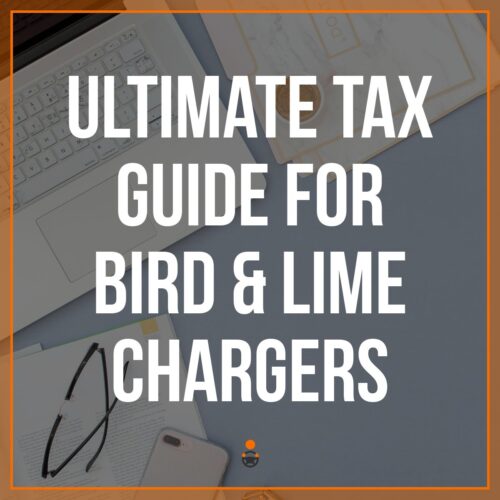A thriving gig economy has made it easier than ever for US workers to pick up a casual side hustle and earn cash on their terms — often using their own vehicle. While this makes things easier on the wallet, it can make for a more complicated tax situation.
There are nearly 2 million taxpayers in the US who drive their car for 1099 contractor or self-employed work, like Uber, Lyft, or DoorDash.
If you fall into this category, you can claim car-related expenses on your tax return. You can write off car expenses based on total miles driven for work, or opt to write off the actual car expenses.
With either method, there are pros and cons. This article will go over what you need to know about both tax filing methods. We’ll go over different scenarios when one method might be appropriate, and answer common rideshare driver FAQs.
Standard Mileage vs. Actual Expenses: How They Work
How Standard Mileage Works
The IRS offers standard mileage deductions as a way to simplify car expense write-offs for individuals who use their own cars for business purposes. Instead of tracking every individual expense related to vehicle upkeep, tied specifically to driving for work, you can just claim the total number of miles driven.
For most taxpayers, this is easier. You don’t need to track and save receipts, recording expenses for car maintenance, gas, and vehicle maintenance — just the miles.
Drivers usually keep track of their miles using their odometer and a journal or notebook, or an expense-tracking app. When it’s time to file your taxes, you can claim any work miles on your return.
Every year, the IRS sets a standard mileage rate deduction. This is the rate per mile that drivers can claim for miles driven for business purposes. It generally gets updated every year, based on gas prices and general market conditions.
This rate is meant to offset the cost of fuel, general wear and tear, and vehicle depreciation. You can’t claim depreciation, oil changes, or fuel, but there are some individual expenses that you can claim on top of the standard mileage deduction:
- Vehicle registration fees
- Parking fees
- Tolls
- Car washes
How Actual Expenses Work
With the actual expenses deduction, drivers can claim all the individual costs they spend on their vehicles. You add up all the actual costs for the tax year and then multiply it by the percentage of time you drove your car for business purposes.
This is called the business percentage rule.
To Calculate Your Business Percentage
Take all your business miles, the miles you’ve driven for work purposes, and divide it by all the miles you’ve put on your car for the year.
( Business Miles / Total Miles ) x 100
As an example, if you drove 15,000 in a year and 5,000 of those miles were for work purposes, you’d take, your business percentage would be 33%.
( 5,000 / 15,000 ) x 100
Business Percentage = 33%
To Calculate Your Actual Expenses
After you have your total business percentage, which is 33% in this hypothetical scenario, you can figure out your actual expenses. You take your business percentage and multiply it times the total vehicle expenses you’ve had for the year.
( Business Percentage x Total Car Expenses )
Continuing our example, if you spent $9,000 on your vehicle last year, your actual work expenses will be $3,000.
( 33% x $9,000 )
Actual Expenses = $3,000
Qualifying car expenses that you can write off using this deduction method include:
- Gas
- Insurance
- Oil changes
- Tire rotation
- Car washes
- Vehicle maintenance
- Lease payments
- Auto loan interest
- Parking fees (ramps, meters)
- Toll roads
- Depreciation deduction
The actual expense method, as you see, can be rather tedious. Especially when it’s for self-employed taxpayers like rideshare drivers and other self-employed gig workers.
Expense-tracking apps, however, can make the process simpler. With apps like QuickBooks or Freshbooks, you can just scan your receipts and turn on mileage tracking features when driving. This is much easier than manual recordkeeping on pen and paper or even a spreadsheet.
With these apps streamlining the process, many taxpayers are switching from claiming the standard mileage deduction to the actual expense method.
Standard Mileage vs. Actual Expenses: Pros & Cons
Pros of Standard Mileage:
- Simplest deduction to claim; just have to keep track of miles.
- Heavy drivers may get a better tax break
Cons of Standard Mileage:
- Many drivers get a smaller tax break using this method.
Pros of Actual Expenses:
- Many drivers (those who drive a typical amount) will get a larger tax break
- Can deduct vehicle depreciation and other expenses
Cons of Actual Expenses:
- Tedious to track and keep a record of all your car expenses
Can You Switch Between Standard Mileage and Actual Expenses?
It depends. If you want to be able to use the standard mileage rate at some point for your tax returns, then you need to do so from the first year that you use your car for business purposes. Then in later years, you can choose to switch back and forth between either method.
If you use the actual expense method in the first year, then you are required to use this deduction method for that same specific vehicle in every future year’s return.
Many drivers choose the tax return method that will give them the larger deduction. However, using the standard mileage rate for the first year does give greater flexibility for future year returns. With the standard mileage method, you can switch between either option in future years – for the life of the vehicle.
Should You Use the Standard Mileage or Actual Expenses Method?
It depends. Everyone’s tax situation is different, and what’s best in one tax year may not be the best in the following. For specific tax advice about your personal situation, you should speak with an accountant or certified tax professional.
In general, the average driver will save more by claiming their total actual expenses. Let’s say you drive 10,000 per year and claim 50% of those miles as business driving. Claiming 5,000 miles at the current mileage deduction rate, you would write off $3,275.
If you claimed actual expenses, however, you could write off 50% of your lease payments or car loan interest, car insurance, gas, car washes, and other expenses, as well as the vehicle depreciation deduction.
For a $30,000 vehicle, the depreciation deduction alone could be $6,000. If you added in 50% of just gas and car insurance, that could be another $1,000 to $2,000.
Most heavy drivers save more by claiming the standard mileage deduction. This includes full-time rideshare or delivery drivers who may drive 40 to 60 hours a week. If you drove 20,000 for work last year, that would be a deduction of $13,100.
Frequently Asked Questions
Here are some of the most popular FAQs that readers have about tax deductions related to driving for Uber or other business purposes.
How do you categorize rideshare expenses?
For rideshare drivers, you will report business income and business expenses on Schedule C. There are two (2) main categories for rideshare business expenses:
- Common operating expenses: Wireless plan, phone, phone accessories, memberships, parking, tolls, passenger accommodations (i.e., snacks)
- Vehicle expenses: Uses the actual method or standard method.
- Actual expenses: Gas, vehicle depreciation, car insurance, lease payment, repair, maintenance, vehicle registration, car washes
- Standard Mileage: Rate per mile driven for business purposes
Some business items, though, may fall into the category of a business expense and a personal expense. Examples include your cell phone, wireless plan, or car mount.
To claim these overlapping expenses, you would need to calculate and claim the business portion of use. So if you used your phone 25% of the time for work, you could claim 25% of your phone expenses.
For any expenses that you do claim, you must have documentation for the IRS in the form of receipts, statements, mileage logs, and the like. Drivers often find using a separate bank account or credit card account for business expenses to be helpful so they can accurately keep their transactions separate.
What form do Uber drivers need to report car expenses?
Rideshare drivers and other self-employed individuals can report car expenses by filling out a Schedule C form along with the 1040 form.
Almost all U.S. individual taxpayers fill out a Form 1040 or variant (1040A or 1040EZ).
But the Schedule C form, short for “Form 1040, Schedule C – Profit or Loss from Business,” is for filers with other business income, earnings, or losses to declare.
Uber does provide its drivers with a yearly 1099 form and a Tax Summary, which details miles driven, toll roads, and payment processing fees — information that can be helpful for tax season.
What are the best mileage tracker apps for Uber drivers?
There are several popular, easy-to-use apps for Uber drivers to track their business mileage and other related expenses, including TripLog, MileIQ, and our favorite, Solo.
The Solo app is designed to meet the needs of gig workers. Within one program, it tracks earnings, business expenses, and vehicle mileage and it can even make tax projections.
A unique feature we especially like is the app’s Smart Schedule. Available in over 90 metro areas throughout the country, Smart Schedule uses earning data and AI to predict the best hours and areas for you to work within your market.
What is the standard mileage rate in 2023?
In 2023, the IRS set the standard mileage deduction rate at $0.655 (65.5 cents) per mile for business use driving.
The IRS usually updates its standard mileage rate once a year, however, in some years there may not be any change.
In rare instances, it can increase or update the standard mileage rate mid-year or at other intervals as appropriate. For the 2022 filing year, due to soaring gas prices, the IRS updated its standard mileage rate for the second half of 2022.
The IRS also offers a similar standard mileage rate deduction for miles driven for volunteer work, medical treatment, moving purposes, or for active-duty military. The deduction rates, however, are set at a different (lower) amount.
How does the depreciation deduction work?
The depreciation deduction can be used by drivers filing their taxes using the actual expense method. Here, if you use your own car for business purposes, you can deduct the cost or value of your car over a five (5) year period through depreciation.
As your vehicle lowers in value over five (5) years, you can calculate its lost value and claim it on your tax return.
There are caps on the value of a vehicle you are claiming (i.e., you can’t deduct expenses for a sports car worth $100,000), and different formulas to calculate the depreciation, including the straight-line method or MACRS 150% Declining Balance.
While this may seem complicated, this depreciation deduction could be your largest tax deduction. This one figure alone could be as high as $12,200 within one tax year.
Can you write off parking tickets or driving fines?
No, so avoid them. Beyond being unable to write off parking tickets, moving violations, or other related fines, these could jeopardize your job as a rideshare or delivery driver.



